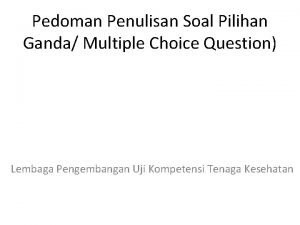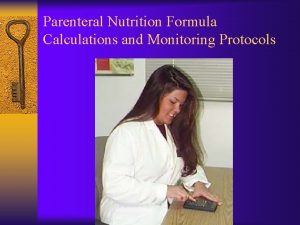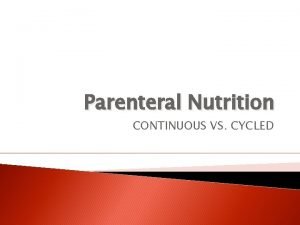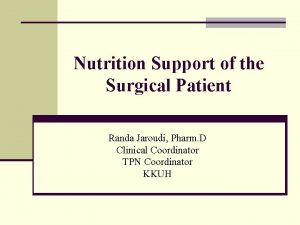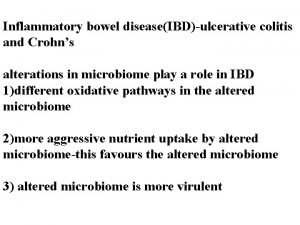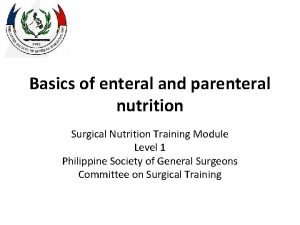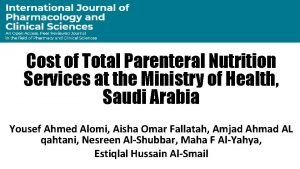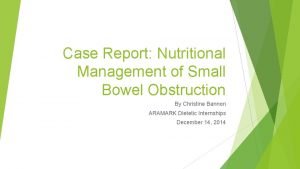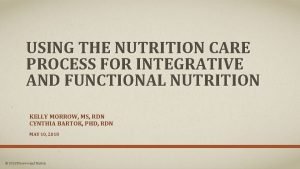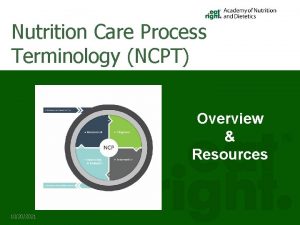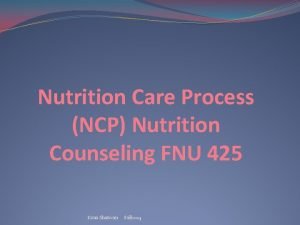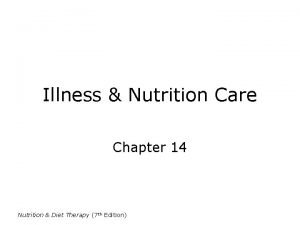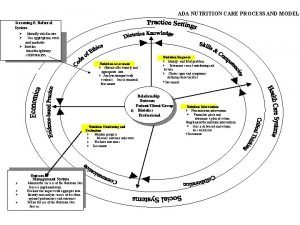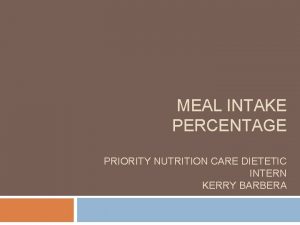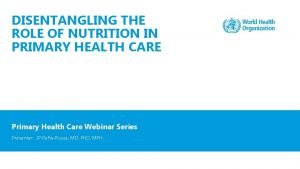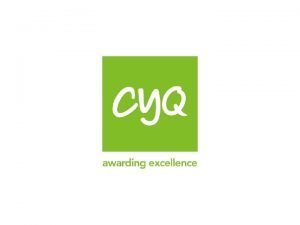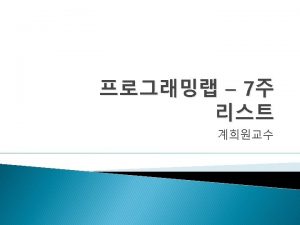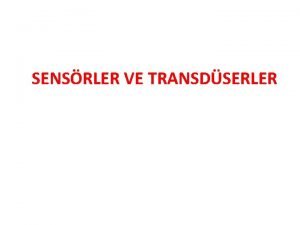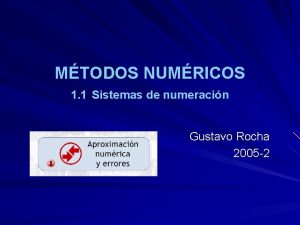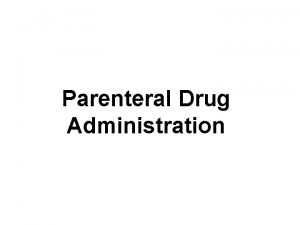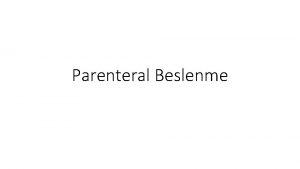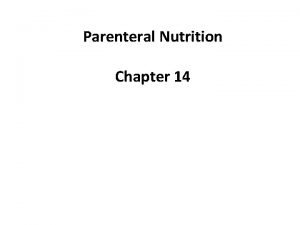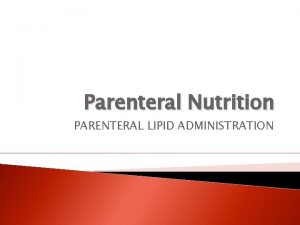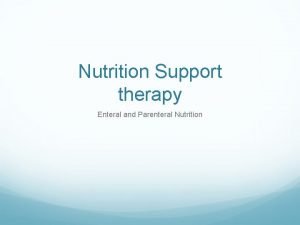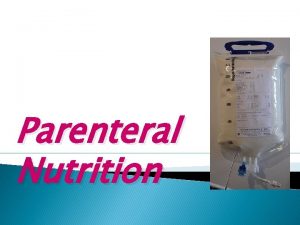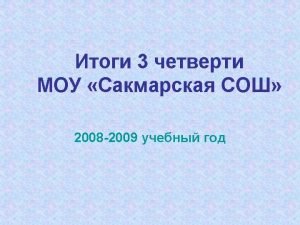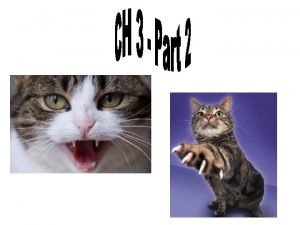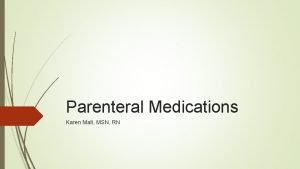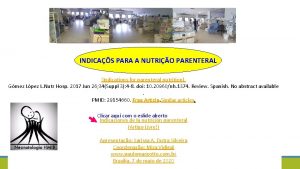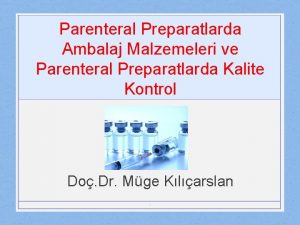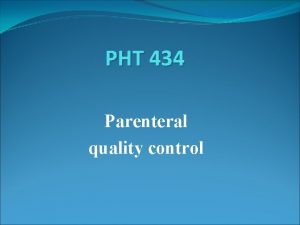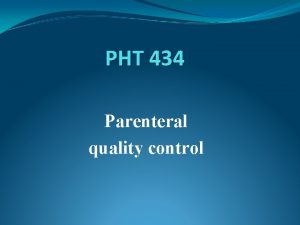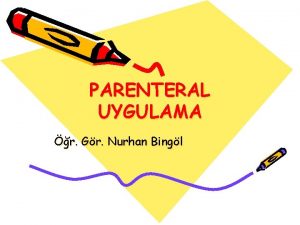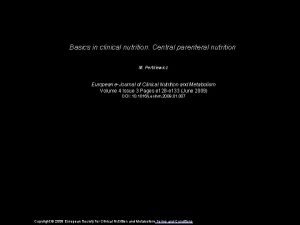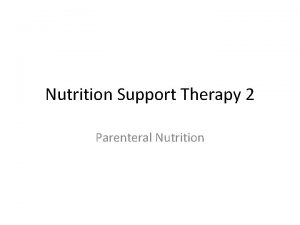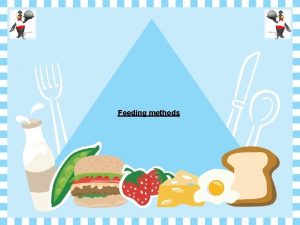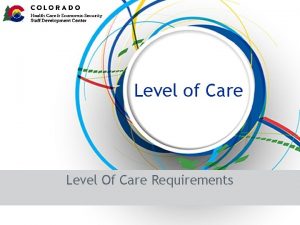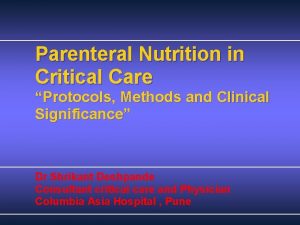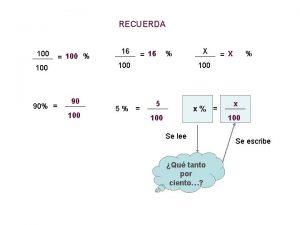Parenteral Nutrition Level 100 Course 2016 Option Care






































- Slides: 38

Parenteral Nutrition Level 100 Course © 2016 Option Care Enterprises Inc. All rights reserved. 1

Outline • Introduction to parenteral nutrition (PN) • Components of PN • Types of nutrition administration • Compounding techniques • Referral and intake process • Nutrition assessment • Administration • Management of nutrition support patients • Physiologic and mechanical complications • Special patient populations © 2016 Option Care Enterprises Inc. All rights reserved. 2

Introduction to Parenteral Nutrition © 2016 Option Care Enterprises Inc. All rights reserved. 3

Parenteral Nutrition (PN) • PN is used for patients who have a functional impairment of the gastrointestinal tract that prevents nutrients from being absorbed well to maintain nutritional status • The first patient received home infusion Parenteral Nutrition (PN) in 1968 • The American Society for Parenteral and Enteral Nutrition (ASPEN) estimated that over 10, 000 outpatients and 25, 000 -30, 000 inpatients receive PN at a given time in the US • PN was previously called Total Parenteral Nutrition (TPN) © 2016 Option Care Enterprises Inc. All rights reserved. 4

What are alternative care settings for home infusion? • Alternative care settings are outpatient options for infusion including: • Patient homes • Ambulatory infusion centers • Physician-based • Hospital-based • Ambulatory infusion clinics infusion suite of the home infusion therapy provider © 2016 Option Care Enterprises Inc. All rights reserved. 5

Why a patient may need PN PN is only considered when adequate nutrition is not being maintained through the gastrointestinal tract • Some reasons a patient may need PN include: • Intestinal failure due to conditions such as Crohn’s Disease, Short Bowel Syndrome, etc. • Acute pancreatitis • Congenital conditions such as developmental failure • Tumors • Obstructions • Secondary gastrointestinal effects from chronic diseases • And so on • © 2016 Option Care Enterprises Inc. All rights reserved. 6

What is needed for a patient to receive PN • Before starting PN, certain patient criteria should be looked at • Documented medical necessity • Diagnosis and prognosis • Possible complications from oral or enteral methods • Previous unsuccessful attempts to treat by enteral route • Precertification from third parties and Medicaid programs • Does a patient with Medicare meet requirements set by Medicare © 2016 Option Care Enterprises Inc. All rights reserved. 7

What is needed for a patient to receive PN • A written order from a licensed prescriber with components, quantities, volumes, infusion rates, type of infusion device, frequency, restrictions, nursing orders, etc. • Baseline weight, height, vital signs, labs • A complete medication list with prescriptions, OTCs, home remedies, supplements to be reviewed by a pharmacist • Preferably before starting PN © 2016 Option Care Enterprises Inc. All rights reserved. 8

Components of Parenteral Nutrition © 2016 Option Care Enterprises Inc. All rights reserved. 9

Components of PN • Each PN is individualized to the patient and may contain: • Protein in the form of amino acids • Calories in the form of dextrose or combination of dextrose and fat • Fluids • Fat (lipid) emulsions • Electrolytes – sodium, potassium, chloride, magnesium, phosphorous, acetate, calcium • Vitamins – A, B, C, D, E, K, biotin, folic acid • Trace metals – zinc, copper, manganese, chromium, selenium, iodine • Other additives – iron, insulin, H 2 blockers (e. g. ranitidine), heparin, albumin, metoclopramide, L-carnitine, choline © 2016 Option Care Enterprises Inc. All rights reserved. 10

Types of Nutrition Administration © 2016 Option Care Enterprises Inc. All rights reserved. 11

Peripheral Parenteral Nutrition (PPN) • Usually reserved for patients that need short term therapy (< 5 -7 days) that do not suffer severe malnutrition, are not fluid restricted, and have good peripheral venous access • Solutions contain diluted amino acids and electrolytes and dextrose or glycerol for calories • May see formulations with fat emulsions as an additional calorie source © 2016 Option Care Enterprises Inc. All rights reserved. 12

Peripheral Parenteral Nutrition (PPN) • • Advantages • Peripheral or midline placement instead of central line • Commercially made solutions available Disadvantages • Daily requirements cannot be met without a large volume • Provides minimum calorie and protein • Meant for short-term use only • Can irritate peripheral veins and make it more difficult to maintain • Frequent change of venous access is needed © 2016 Option Care Enterprises Inc. All rights reserved. 13

Parenteral Nutrition (PN) • PN provides complete nutrition through a central line • Previously known as “Total Parenteral Nutrition (TPN)” but shorted to PN • Contains amino acids and glucose concentrations higher than can be used in peripheral parenteral nutrition • May be referred to as “ 2 in 1” also • Can contain electrolytes, vitamins, trace metals, and other additives as needed • Fat emulsion is given separately from PN © 2016 Option Care Enterprises Inc. All rights reserved. 14

Parenteral Nutrition (PN) • • Advantages • Adequate amounts of nutrients, calories, and volume to be used long term • Can use a micron filter to filter out bacteria • Can visually see if there are issues with the solution Disadvantages • Has to be given through a central line • Potential complications due to concentrations of components and rapid administration • More line manipulations needed and greater risk of infection or human error • More pumps, sets, and time needed • Potential for non-compliance © 2016 Option Care Enterprises Inc. All rights reserved. 15

Total Nutrient Admixtures (TNA) • Administration of complete nutrition through a central line • Difference between PN and TNA is that the fat emulsion is added into the glucose and amino acid solution for TNA • High concentration of glucose and amino acid requires use of a central line • Also known as “all in one”, “ 3 in 1”, or “triple mix” © 2016 Option Care Enterprises Inc. All rights reserved. 16

Total Nutrient Admixture (TNA) • • Advantages • Contains adequate components to be used long term • Fewer line manipulations needed than PN and less risk for infection and human error • Simplified process (fewer pumps, sets, supplies needed) • May lead to better utilization of lipids and may decrease insulin resistance Disadvantages • Has to be given through a central line • Not able to use bacteria micron filter • Cannot visually see issues with solution • Incompatible with many additives and some amino acids • Large fat particles can block filter © 2016 Option Care Enterprises Inc. All rights reserved. 17

Cyclic PN Therapy • Type of PN that is given over a limited number of hours • Limited hours of infusion help free patient for activities of daily living • Reserved for patients that are metabolically stable and can handle periods of infusion • Cardiovascular and renal systems have to be able to handle increased volumes during infusion periods • A patient may switch from continuous therapy to cyclic therapy by decreasing infusion time and increasing the rate • Cyclic therapy can vary from 10 to 20 hours depending on the patient’s response and tolerance to infusion © 2016 Option Care Enterprises Inc. All rights reserved. 18

Cyclic PN Therapy • • Advantages • Improved quality of life and compliance by allowing patient to resume normal daytime activities • Can reduce liver problems because of rest period between infusions • May help transition to oral diet by allowing hunger response to resume during noninfusion hours Disadvantages • More nursing time may be needed at first to teach • May not be appropriate for some patients if their cardiovascular system is not able to handle an increase in fluid volume during infusion hours • May not be advantageous for patients that require strict “NPO” (nothing by mouth) © 2016 Option Care Enterprises Inc. All rights reserved. 19

Compounding Techniques © 2016 Option Care Enterprises Inc. All rights reserved. 20

Compounding • It is necessary to use a laminar flood hood for PN • PN • has to be prepared under sterile conditions • High Efficiency Particulate Air (HEPA) filters remove 99. 97% of particles • Flow of air sweeps the work area and prevents contamination Automated admixture devices • Automated and safety • Requires intensive • compounding devices are preferred because of increased accuracy less manipulation of final bag, streamlines inventory, and is less labor Non-automated admixture • Done by hand follows a sequence of steps © 2016 Option Care Enterprises Inc. All rights reserved. 21

Referral and Intake Process © 2016 Option Care Enterprises Inc. All rights reserved. 22

Initial Responsibilities • Initial responsibilities • Assessment in the hospital before discharge is helpful • Introduction • Review to patient, caregiver, family member is important patient chart and get necessary documents • Coordinate with social work/case manager • Determine if the patient is appropriate for home care • Caregiver, significant other, or family member must be available and understand requirements • Home environment and facilities must be adequate • Reimbursement • Obtain needs to be considered before starting the most recent PN order 24 -hours before discharge • Let patient, caregiver, and family member know when visiting nurse and delivery driver is scheduled to arrive © 2016 Option Care Enterprises Inc. All rights reserved. 23

Patient Visits • • First visit • Resources that are used include PN Patient Education guide and PN Clinical Nursing Pathway • Assess patient, help ease anxiety levels, organize and prepare supplies • Educate patient and caregiver about setup and how to use PN Second visit • • Continue to use teaching materials and checklists to assess and train patient Third visit • Continue to assess patient • Frequency of visits may depend on • Acuteness • Learning • Anxiety of illness and patient ability to perform activities of daily living style level © 2016 Option Care Enterprises Inc. All rights reserved. 24

Nursing Interventions During Home Care Visits • Nurses can help in a variety of ways during home care visits including: • Determining if the patient is having problems with administration/pump • Obtaining blood samples • Checking vital signs and completing physical assessments • Providing emotional support and resources • Reinforcing education or home PN procedures • Reporting any physician visits, ER visits, hospitalizations, and any changes in medication to the health care team • Assisting with arrangement for shipping • Encouraging the patient to receive appropriate immunizations recommended by the doctor © 2016 Option Care Enterprises Inc. All rights reserved. 25

Nutrition Assessment © 2016 Option Care Enterprises Inc. All rights reserved. 26

Nutrition Assessments are the cornerstone of PN • Optimally, a baseline assessment should be done before starting PN and periodically throughout the course of therapy • A number of factors are analyzed during assessments including: • Patient history • Physical assessments • Lab data • Risk factors • Effects of disease states or metabolism on nutritional status and requirements • Anatomic and physiological functions and characteristics • Estimates for nutrient requirements • Goals of therapy © 2016 Option Care Enterprises Inc. All rights reserved. 27

Administration © 2016 Option Care Enterprises Inc. All rights reserved. 28

Infusion devices • Patient needs and items to consider • Pumps capable of large volume infusion rates • Does the pump need to be ambulatory? • Is the patient infusing at night only? • Are their mobility problems? • Can the patient carry two liters of formula if ambulatory? • How is the pump powered? If battery, are they expensive, replaceable, rechargeable, readily available? • Patient training materials • Teaching sheets for specific pumps • Manufacturer’s instruction material or training materials • Filters • All PN (without lipids) need a 0. 22 micron filter • All TNA solutions need a 1. 2 micron filter • Filters, tubing, PN formula must be changed every 24 hours and kept as a closed system whenever possible © 2016 Option Care Enterprises Inc. All rights reserved. 29

Management of Nutrition Support Patients © 2016 Option Care Enterprises Inc. All rights reserved. 30

Management of Nutrition Support Patients • Routine monitoring • • Nutrition assessments • • Should be done at the start of care and periodically after Lab value assessments • • Physical assessments, lab values, potential complications, teaching/learning, supplies Coordinate lab draws and obtain copies of results for patient record Pharmacy assessments • Review of physical assessments, nutritional assessments, lab data, nursing reports • Determine if therapy is achieving results and if equipment is working properly © 2016 Option Care Enterprises Inc. All rights reserved. 31

Management of Nutrition Support Patients • • • Patient/caregiver self-monitoring assessments • Patient/caregiver documentation must be put into the patient’s medical record • Assess if patient/caregiver is reporting problems correctly Patient teaching • Includes use of learning and teaching process steps, educational tools, teaching techniques • A major goal of patient education is patient compliance Monitoring lab test results • • Each lab test has its own reference range for normal values Lab test and nutrition considerations • Adjust components of PN as needed to be within the reference range for normal values © 2016 Option Care Enterprises Inc. All rights reserved. 32

Physiologic and Mechanical Complications © 2016 Option Care Enterprises Inc. All rights reserved. 33

Physiologic Complications • Complications that may occur with PN • High blood sugar • Low blood sugar • Electrolyte imbalances • Fluid overload • Dehydration • Acid base imbalance • Allergic reaction • Infection • Liver function test abnormalities • Overfeeding • Gallbladder complications • Refeeding syndrome © 2016 Option Care Enterprises Inc. All rights reserved. 34

Mechanical Complications • • PN-catheter related • Occlusions • Dislodging of catheter • Thrombus formation • Subjective complaints such as discomfort in arm, neck, shoulder, or chest In-line filtration • Lipid emulsion causing clogs of 0. 22 micron filters • TNA infusions require 1. 2 micron filters © 2016 Option Care Enterprises Inc. All rights reserved. 35

Special Patient Populations © 2016 Option Care Enterprises Inc. All rights reserved. 36

Special Patient Populations • Nutritional requirements may need to be adjusted for different patient populations • Pediatric patients • Infants, • Dosing all components of PN can be critical in pediatrics • Growth • children, and adolescents; typically birth to 18 years of age charts are used in addition to clinical pathways to monitor patients Elderly patients • Over • Loss age 65 of lean body mass, increase in total body fat, decrease in total body water • Decrease • in energy and calorie needs Pregnant patients with hyperemesis gravidarum • Severe and persistent type of nausea and vomiting © 2016 Option Care Enterprises Inc. All rights reserved. 37

Thank you © 2016 Option Care Enterprises Inc. All rights reserved. 38
 100 100 100 100 100
100 100 100 100 100 Question option 1 option 2
Question option 1 option 2 Stock options terminology
Stock options terminology Tpn calculations
Tpn calculations Tpn cycling
Tpn cycling Complication of parenteral nutrition
Complication of parenteral nutrition Ppn vs tpn
Ppn vs tpn Enteral
Enteral Tpn complication
Tpn complication Total parenteral nutrition cost
Total parenteral nutrition cost Small bowel obstruction nutrition management
Small bowel obstruction nutrition management Primary secondary tertiary care nursing
Primary secondary tertiary care nursing Microsoft official academic course microsoft word 2016
Microsoft official academic course microsoft word 2016 Microsoft official academic course microsoft excel 2016
Microsoft official academic course microsoft excel 2016 Microsoft official academic course microsoft word 2016
Microsoft official academic course microsoft word 2016 Nutrition care process
Nutrition care process Nutrition care process terminology
Nutrition care process terminology Diabetes pes statement
Diabetes pes statement Nutrition diagnosis domains
Nutrition diagnosis domains Chapter 14 nutrition and fluid balance
Chapter 14 nutrition and fluid balance Nutrition care process
Nutrition care process Abbott percentage of intake chart
Abbott percentage of intake chart Nutrition in primary health care
Nutrition in primary health care Cyq level 3 certificate in personal training
Cyq level 3 certificate in personal training One and a half brick wall
One and a half brick wall Course number and title
Course number and title Chaine parallèle muscle
Chaine parallèle muscle 200 ün %25 fazlası
200 ün %25 fazlası 200+200+100+100
200+200+100+100 Box plots gcse questions
Box plots gcse questions Malloc lab 100/100
Malloc lab 100/100 1453-1337
1453-1337 100+100=200
100+100=200 100 iops/gb and 100,000 iops per volume oci
100 iops/gb and 100,000 iops per volume oci 200+200+300+300
200+200+300+300 C/100=f-32/180=k-273/100
C/100=f-32/180=k-273/100 What's 100 + 100
What's 100 + 100 200 200 300
200 200 300 Números romanos del 200 al 500
Números romanos del 200 al 500

